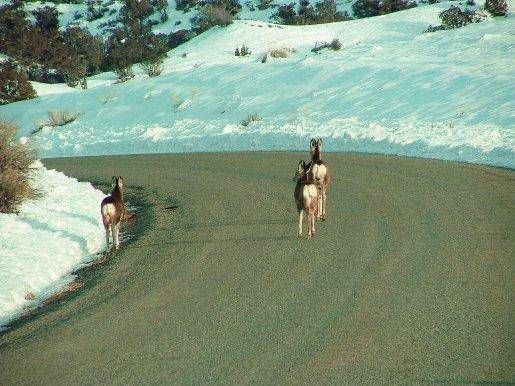Book Cliffs — Did you know that vehicles affect Utah’s deer herds more than hunters do? It’s true.
Wildlife biologists and researchers estimate that vehicles may kill as many deer in Utah every year as hunters do. (During the 2009 hunting season, hunters took about 23,000 deer.) But it’s the part of the population cars take that makes the difference.
Hunters take mostly bucks.В But cars mostly kill the deer that are the key to the future growth of Utah’s deer herds — does and fawns. Fortunately, new and innovative road structures are helping reduce the number of deer that are hit and killed by cars in the state.
A proposal to pave a road through the Book Cliffs in eastern Utah is a good example of two things: the effect roads can have on deer, and steps transportation officials and wildlife biologists are taking to help deer out.
Seep Ridge Road
Thoughts about paving Seep Ridge Road through the Book Cliffs have been around since the first driver tried to negotiate the area’s rugged terrain. The Bureau of Land Management, the largest land manager in the Book Cliffs, is currently reviewing a proposal from Uintah County to extend the pavement roughly 45 miles, from Ouray to Interstate 70.
Biologists with the Utah Division of Wildlife Resources are concerned about the effect the road change could have on the deer herd in the Book Cliffs, which is one of the state’s premier herds. Biologists have found that mule deer are highly sensitive to change.
Concerns
The UDWR’s main concern about the paving project is the increased speed and width of the road, both of which will likely result in more deer being killed by vehicles.
The proposed 45-mile stretch is currently an improved gravel road.В The speed limit is 35 miles per hour.В The road contains numerous speed barriers — including blind corners, slick gravel, dips, washboards and mudholes — that keep drivers from going much over that limit.
The paving proposal would increase the speed limit to 55 mph and almost triple the width of the road.В It would also eliminate most of the barriers that keep people from driving too fast.
At the higher speeds, it’s highly likely that more deer will be hit and killed. The question is: How many deer will be killed? And how will the loss of these additional does and fawns change the size and structure of the deer herd?
A 22-mile stretch of U.S. Highway 40 between Current Creek and Duchesne provides some clues.В This stretch crosses crucial winter range, just like Seep Ridge Road does.
In 2009, contractors and wildlife personnel removed 132 dead deer from the highway. In 2010, they collected 121. These figures equal about six deer per mile. But what the figure doesn’t show is the number of deer that were hit by cars but moved away from the road before they died.
Studies estimate the number of deer that are found and collected from a highway represent less than 50 percent of the deer that were actually killed.В Other studies suggest the number of deer found might be as low as 12 percent of the deer that were actually killed.
In other words, many more deer were killed than the collectors found. And remember, most of these deer were does and fawns.
Helping deer
The UDWR has suggested some possible actions that could be taken to reduce the number of deer that will be killed if Seep Ridge Road is paved:
- Constructing wildlife crossing structures that deer can use, and fencing the right-of-way, can help a lot.
UDWR studies have found that if adequate crossing structures are built in the right place, deer will use them to cross over or under a road.
Ideally, these crossings should be placed every two miles.В This distance corresponds withВ studies that show deer will follow a fence for roughly a mile before they give up trying to find a gap through the fence.
During discussions with the UDWR and other state officials, Uintah County has agreed to pay for the installation of six underpasses along the stretch of the road that provides the most crucial deer winter range.В The county has also agreed to fence an undetermined portion of the road.
The underpasses will be strategically placed to give deer and other wildlife the best place to cross. They’ll also provide a culvert for water that flows through washes in the area.
- In another cooperative effort, the UDWR and Uintah County are conducting a study to learn how many deer die in the Book Cliffs each year.В The study, which started in November 2009, will provide a baseline to evaluate the effect paving the road has on the herd.
The UDWR does not have the authority to make a decision about the Seep Ridge Road.В Instead, the agency serves as a consultant to help protect and enhance the Book Cliffs deer herd and other wildlife in the area.

